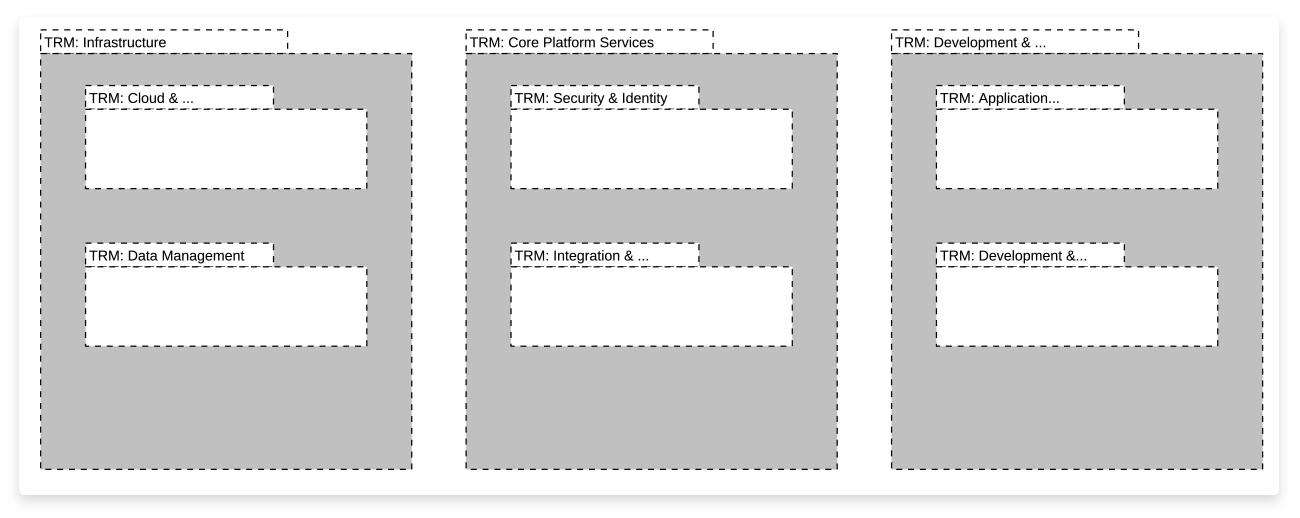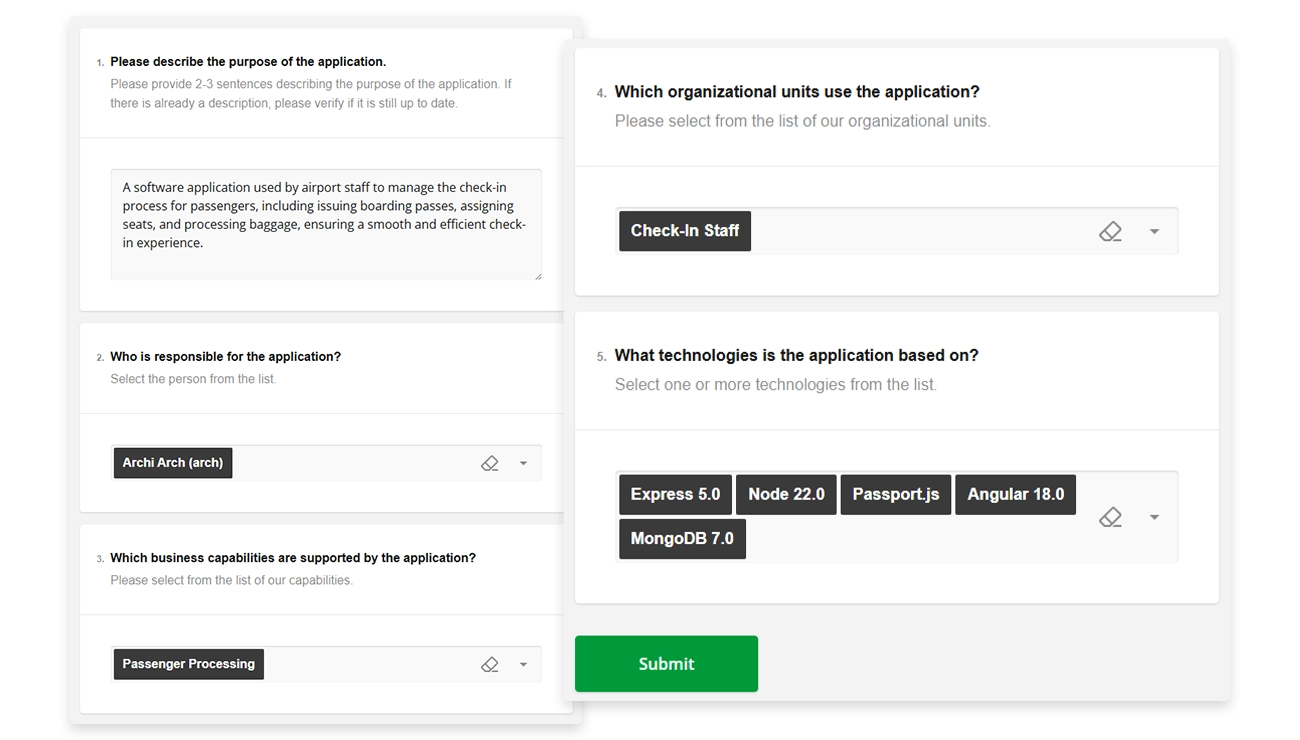Found this helpful? Share it with peers.
The Hidden Cost of Outdated Technology
Every enterprise runs on technologies that quietly age in the background, still running, still critical, but slowly holding everything back. Unsupported databases, legacy runtimes, and forgotten APIs drain resources and introduce unseen risk.
Technology Lifecycle Management (TLM) provides the discipline to fix that. As part of modern Enterprise Architecture practice, TLM gives organizations a structured way to track, evaluate, and manage every technology, from adoption to retirement, so modernization becomes a plan, not a panic.
In this blog, we explore what Technology Lifecycle Management is, why it matters more than ever, and how enterprises can build lifecycle transparency that keeps their IT portfolios current, compliant, and ready for change.
What Is Technology Lifecycle Management?
Technology Lifecycle Management (TLM) is about keeping full oversight of how technologies evolve — from their first rollout to final phase-out. It provides a structured way to track and govern every technology through its introduction, growth, maturity, decline, and retirement.
At its core, TLM connects Enterprise Architecture (EA) and Technology Portfolio Management. This link ensures that architectural choices, investment plans, and risk assessments are grounded in reliable lifecycle data rather than assumptions or outdated inventories.
Where IT asset management focuses mainly on ownership and inventory, TLM takes a strategic view. It looks at whether a technology still supports business goals, fits the target architecture, and continues to meet security and cost requirements.

Technology reference model – structured overview of domains and ownership
Organisations with a mature approach often manage TLM through EA platforms such as BOC Group’s ADOIT. By combining a central repository with lifecycle insights, these tools make it possible to see exactly where each technology stands. What’s stable, what’s approaching end-of-life, and what needs attention next.
Why Lifecycle Management Matters More Than Ever
Outdated technology carries hidden costs. It increases maintenance overhead and exposes organizations to compliance and security risks. With technology lifecycles accelerating, and cloud, SaaS, and AI platforms changing monthly, unmanaged sprawl becomes a liability.
Modern Technology Lifecycle Management, integrated with Technology Portfolio Management, helps organizations:
-
Reduce risk: identify unsupported or vulnerable technologies before they fail.
-
Optimize costs: eliminate redundancy and plan replacements strategically.
-
Drive agility: free resources for innovation instead of firefighting.
-
Stay compliant: ensure all components meet governance and regulatory standards.
Organizations that regularly assess their lifecycle health have been shown to reduce maintenance costs by up to 30% and accelerate modernization cycles dramatically.

Technology lifecycle timeline highlighting end-of-life risks and gaps
The Core Stages of a Technology Lifecycle
Understanding where a technology stands in its journey is the basis of good governance:
| Stage | Description | Typical Action |
|---|---|---|
| Introduction | A new technology enters evaluation or pilot stage. | Assess potential and alignment with strategy. |
| Growth | Broader adoption across projects. | Define standards and ownership. |
| Maturity | Stable, mission-critical use. | Monitor versions and plan for future updates. |
| Decline | Support costs rise; innovation slows. | Prepare replacement or migration plan. |
| Retirement | Technology phased out and decommissioned. | Ensure continuity and knowledge transfer. |
These stages form the backbone of modern lifecycle governance frameworks implemented in enterprise architecture tools. Modern EA platforms visualize these stages across the IT landscape, offering instant transparency into lifecycle health and end-of-life timelines.
The TOGAF TRM: A Strong Foundation That Needs an Update
For many years, the TOGAF Technical Reference Model (TRM) has been the standard way to structure enterprise technology. It separates business applications from platform services, runtimes, and infrastructure – and it worked well in a world of monolithic systems and static data centres.

The classic TOGAF Technical Reference Model (TRM)
But today’s environments look nothing like that. Cloud-native platforms, API-first services, distributed data systems, and AI technologies have changed the architecture landscape completely. Traditional TRMs do not account for AI, DevOps, observability, or cross-cutting capabilities that are now essential.
This gap makes it difficult to track lifecycle risks or understand dependencies across modern architectures.
Many organizations now need a modernized Technical Reference Model (TRM) – one that keeps the clarity of the classic model but extends it with platform-centric and AI-aware domains.
Hint: If you want a ready-to-use example, download our Technical Reference Model for the AI Era. It shows how a traditional TRM can be updated for cloud, AI, and automation portfolios.

Modernized TRM: A platform- and capability-centric view aligned with today’s architecture needs
AI as the Ultimate Test for Lifecycle Management
AI technologies evolve faster than any other category. New model versions appear monthly, APIs change, and licensing terms shift without notice. This volatility makes AI the perfect example of why structured lifecycle management is essential.
Treating AI as a governed technology domain, rather than an experiment, allows organizations to manage it with the same discipline as databases or runtimes. Within a Technical Reference Model (TRM), AI should appear as a first-class platform capability, complete with sub-domains such as:
-
Generative AI: GPT-4, DALL·E, Claude
-
Conversational AI: Azure Bot Service, Amazon Lex
-
Text & Document Understanding: Amazon Comprehend, Textract
-
Forecasting & Optimization: SageMaker Canvas, Amazon Forecast
-
AI Lifecycle Management: AutoML Tabular, Explainable AI
Managing these domains within a TRM supports ownership clarity, lifecycle tracking, and reuse across applications. When AI lifecycles are monitored just like any other technology, often supported by an AI lifecycle management solution, enterprises can:
-
Anticipate API or model deprecations.
-
Plan retrains and migrations ahead of time.
-
Maintain compliance and documentation continuity.
It’s proof that governance enables innovation, not the other way around. And it shows why every modern organization needs a Technology Lifecycle Management solution to bring consistency and control to rapidly evolving domains like AI.
Tools and Capabilities That Power Lifecycle Management
Modern technology lifecycle management solutions rely on structured data, automation, and analytics to keep portfolio information accurate and actionable.
Core Capabilities
-
Central repository for all technologies, versions, and ownership.
-
Automated End-of-Life (EoL) tracking based on vendor feeds.
-
Dashboards showing lifecycle health and risk exposure.
-
Integration with portfolio, project, and capability layers.
-
AI-driven recommendations for modernization priorities.

ADOIT Forms – linking applications with their supporting technologies
AI in Action: From Manual Tracking to Smart Decisions
Collecting EoL information used to mean hours of manual research. Today, AI can retrieve and validate lifecycle data automatically – flagging technologies nearing end of support and suggesting replacements based on dependencies and business impact.
BOC Group’s enterprise architecture platform ADOIT exemplifies this shift. Its AI-powered lifecycle management automatically updates support timelines, surfaces expiring technologies, and links them directly to affected applications and capabilities – transforming end-of-life tracking into a continuous, intelligent process.
Hint: See how ADOIT transforms end-of-life tracking from a manual chore into an automated, insight-driven part of enterprise architecture
Common Lifecycle Challenges (and How to Avoid Them)
Even with the right tools, organizations stumble when:
-
Decisions are reactive: upgrades start only after issues appear.
-
Data is incomplete: vendor or version info is missing or inconsistent.
-
Ownership is unclear: no defined accountability for lifecycle updates.
-
Planning is disconnected: lifecycle data never feeds portfolio or roadmap decisions.
Successful lifecycle management practices require automation, clear governance roles, and regular review cadences so lifecycle data remains accurate and actionable.
From Lifecycle Transparency to Modernization Strategy
Lifecycle visibility turns static portfolios into living modernization maps. When each technology’s stage and dependencies are known, enterprises can:
-
Identify high-risk or obsolete components early.
-
Prioritize modernization based on business impact.
-
Synchronize new technology adoption with retirement plans.
This continuous renewal loop, new technologies in, outdated ones out, keeps architecture resilient and innovation sustainable. Linking lifecycle insights with technology portfolio planning and modernization initiatives ensures architecture evolves deliberately, not reactively.
Make Lifecycle Management Part of the Plan, Not the Panic
Technology Lifecycle Management gives organisations a structured way to keep technologies modern and risk-ready. When lifecycle oversight is formalised, teams can identify outdated software, unsupported platforms, or obsolete integrations early and maintain long-term value across their systems.
Solutions such as ADOIT Technology Lifecycle Management make this discipline practical by centralising lifecycle data, enriching it with AI, and linking it directly to enterprise roadmaps. Because in modern IT, the question isn’t whether technologies will change – it’s whether you’ll be ready when they do.




